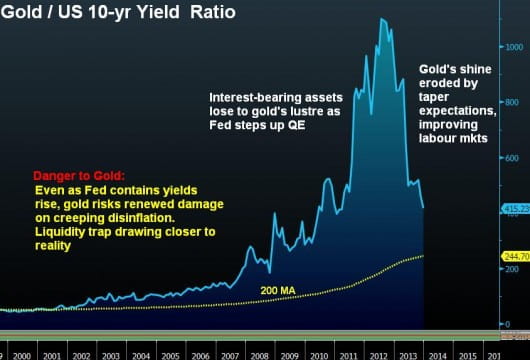Fed tapers amp shifts from unemployment to inflation
The Federal Reserve has successfully integrated the price stability component of its dual forward guidance into traders’ psyche by further delinking tapering of asset purchases […]
The Federal Reserve has successfully integrated the price stability component of its dual forward guidance into traders’ psyche by further delinking tapering of asset purchases […]
The Federal Reserve has successfully integrated the price stability component of its dual forward guidance into traders’ psyche by further delinking tapering of asset purchases from tightening conditions in the bond market.
Unemployment was Fed’s priority in 2013
When Fed Chairman Bernanke was forced into producing a 3rd round of quantitative easing due to modest improvement in the economy in mid- 2012, he constantly cited reducing the unemployment rate as the chief priority to policy easing. The majority of Bernanke’s speeches, regardless of the audience, focused on the importance to address the persistent slack in labour markets, a point he particularly emphasized when market conditions had become too tight; i.e. bond yields increased rapidly, the dollar appreciated too fast or when equities piled on losses.
Inflation will be Fed’s priority in 2014
As labour markets stabilized and the unemployment rate fell to 7.0% in November from 7.9% in January, it was not enough for the Fed. Nor it was worth risking a spike in bond yields via a taper. That was especially the case as the labour force participation rate hit 35-year lows at 62.8%.
With 10-year yields standing at 2-year highs and inflation drifting at 2-year lows, the Fed quickly realized that any tapering would provoke an unwanted tightening of market conditions. And thus, the Fed shifted to highlighting the importance of price stability as inflation further deviated away from its 2.0% threshold.
Inflation objective: from anticipation to vigilance
The FOMC statement’s phrasing on inflation was changed from “anticipates” inflation to move towards its objective in October, towards “monitoring” whether “inflation will move back towards its objective”. Said differently, the Fed’s stance on inflation has shifted from that of anticipating a return to target, towards vigilance over whether inflation will decline below 1.0%.
“…recognizes that inflation persistently below its 2 percent objective could pose risks to economic performance, but it anticipates that inflation will move back toward its objective over the medium term.”
“… recognizes that inflation persistently below its 2 percent objective could pose risks to economic performance, and it is monitoring inflation developments carefully for evidence that inflation will move back toward its objective over the medium term.”
Explicit extension of exceptionally low rates
Finally, the Fed has revamped its forward guidance by adding timing uncertainty to macro variables. Previously, the Fed used economic thresholds as a benchmark for guidance. Today, it combines macro reference with verbal leeway for error.
October 30 FOMC
“…anticipates that this exceptionally low range for the federal funds rate will be appropriate at least as long as the unemployment rate remains above 6-1/2 percent, inflation between one and two years ahead is projected to be no more than a half percentage point above the Committee’s 2 percent longer-run goal…”
December 18 FOMC
“…appropriate to maintain the current target range for the federal funds rate well past the time that the unemployment rate declines below 6-1/2 percent, especially if projected inflation continues to run below the Committee’s 2 percent longer-run goal”
5 years ago this week, the Federal Reserve launched its zero interest rate policy. Today, the central bank launches an explicit extension of exceptionally low interest rates. The Fed’s signaling of exceptionally low interest rates into at least 2015 will divert emphasis away from asset purchases towards suppressing bond yields, until unemployment drops below 6.5% and price growth demonstrates durable signs of avoiding disinflation. Until then, both sterling and euro will maintain their resilience against the US dollar as the US central bank is clearly the most consistent and explicit in capping bond yields and extending liquidity, without necessarily producing broad-based growth.
